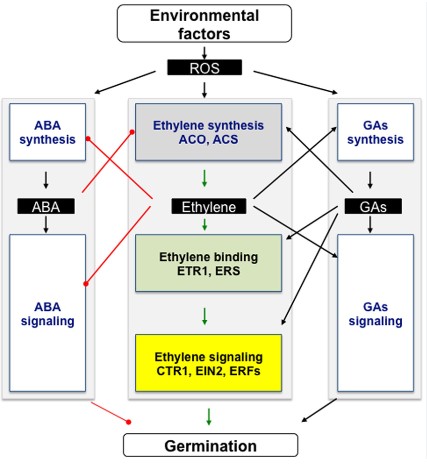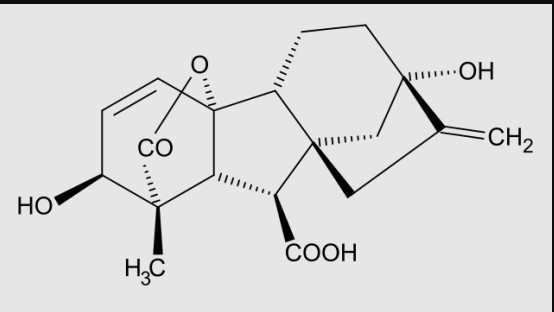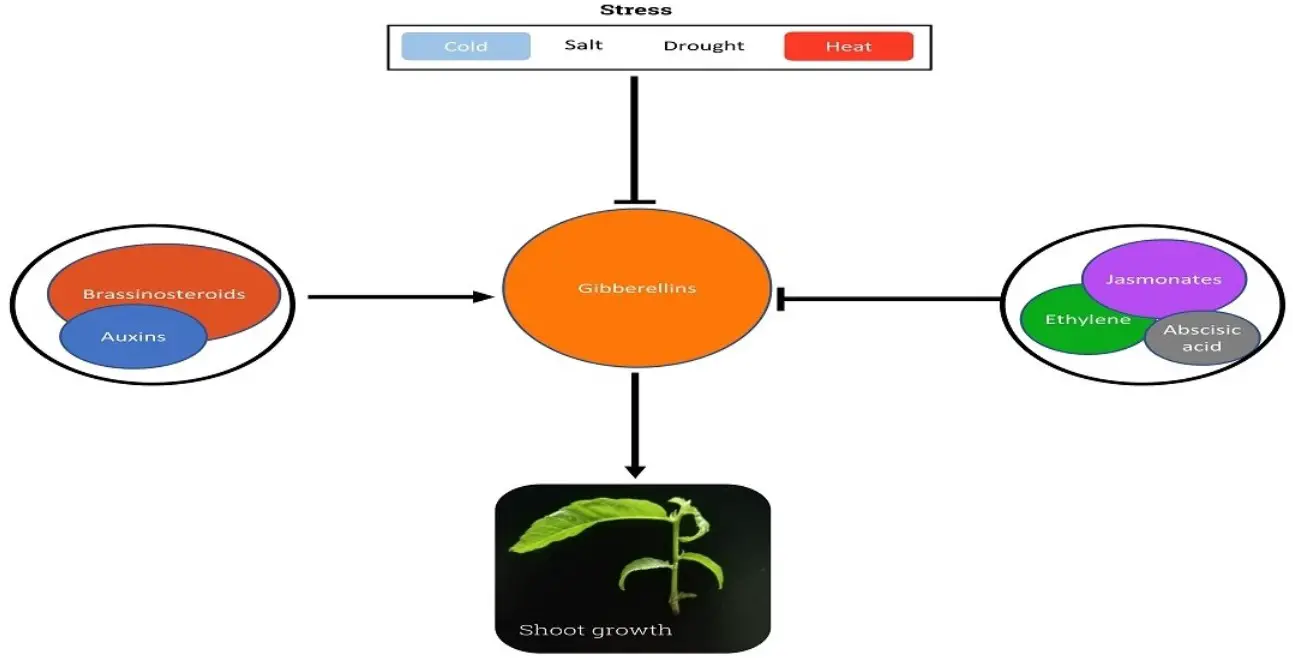Plant hormones play crucial roles in the regulation of physiological processes, impacting everything from growth patterns to stress responses in plants. Among these hormones, abscisic acid and gibberellins stand out due to their distinctive functions and mechanisms of action. This introduction outlines the key differences between these two hormones, which are vital for plant adaptation and development.
Abscisic acid primarily functions as a stress hormone, instrumental in managing plants’ responses to environmental stressors such as drought and cold. On the other hand, gibberellins are growth-promoting hormones, crucial for processes like seed germination, stem elongation, and fruit development. While abscisic acid halts growth and promotes dormancy under adverse conditions, gibberellins work to stimulate growth and developmental transitions.
Understanding how abscisic acid and gibberellins operate not only illuminates their roles in plant biology but also highlights their potential applications in agriculture. By manipulating these hormones, farmers and scientists can enhance crop resilience and yield, which is essential in the context of global climate variability and growing food demands.

Basics of Abscisic Acid
Chemical Structure
Abscisic acid (ABA) is a naturally occurring plant hormone classified as a sesquiterpenoid. This compound consists of a 15-carbon skeleton primarily arranged in a ring structure, which is pivotal for its function. ABA’s chemical formula is C15H20O4, featuring a carboxylic acid group that enhances its solubility in water, an essential trait for its movement within plant tissues.
Production Sites in Plants
ABA is synthesized in the plastids of plant cells, specifically within chloroplasts. It originates from the carotenoid precursors that are also involved in photosynthesis. This hormone is predominantly produced in the leaves of plants, especially in response to environmental stress conditions such as drought or soil salinity. Once synthesized, ABA can be transported to other parts of the plant where it exerts further regulatory influence.
Functions of Abscisic Acid
Stress Responses
One of the key roles of ABA is in stress responses, particularly to drought and salt stress. It mediates the closure of stomata (pores on the leaf surface), reducing water loss through transpiration. This action is crucial for plant survival during water-deficient periods. Moreover, ABA signaling pathways activate the expression of specific stress-response genes that enhance plant resilience against adverse environmental conditions.
Seed Dormancy
ABA significantly influences seed dormancy, a vital process ensuring that seeds only germinate under favorable conditions. High levels of ABA promote the maintenance of dormancy, thereby preventing germination during unsuitable environmental conditions. This mechanism is crucial for the temporal synchronization of life cycles with environmental opportunities.
Stomatal Closure
The role of ABA in stomatal closure is a classic example of its function. When plants face water stress, ABA levels in the leaves increase, triggering a signaling cascade that leads to the influx of calcium ions into the guard cells. This change in ion concentration causes water to flow out of the cells, leading to stomatal closure and a subsequent reduction in water loss.
Basics of Gibberellins
Chemical Composition
Gibberellins (GAs) are a group of diterpenoid acids that are key to promoting growth and development in plants. Unlike the more defensively oriented ABA, gibberellins are primarily involved in growth processes. There are over one hundred different gibberellins identified in various plant species, but they all share a similar gibberellin skeleton—consisting of four rings labeled A, B, C, and D.
Synthesis Locations
Gibberellins are synthesized in young tissues of the shoots and seeds, where growth processes are most active. The biosynthesis of gibberellins takes place in the endoplasmic reticulum through a pathway that transforms geranylgeranyl diphosphate (GGDP) into various forms of gibberellins. After their synthesis, gibberellins are transported to other parts of the plant where they stimulate growth-related responses such as stem elongation, flowering, and seed development.

Functions of Gibberellins
Growth and Development
Gibberellins play a pivotal role in growth and development in plants, influencing various physiological processes. They promote cell elongation and division, particularly in stems and leaves, leading to taller plants with greater biomass. This effect is evident in dwarf varieties of plants, which often lack sufficient gibberellin production; when treated with gibberellins, these plants can attain normal growth.
Germination Effects
Germination is another critical area where gibberellins have a significant impact. They help break seed dormancy, a process that is especially important for seeds that require light to germinate. Gibberellins signal the seed to start the developmental processes, leading to the growth of the embryo within the seed.
- Hydrolyzing enzymes: Gibberellins stimulate the production of enzymes that break down the starches and proteins stored in seeds into simpler molecules that the growing plant can use as food.
- Embryo growth: They also promote the growth of the embryo, pushing it out of the seed casing.
Flowering and Fruiting
Gibberellins are crucial in flowering and fruiting. They can induce flowering in some plants under non-inductive conditions and increase fruit size and quality by promoting cell division in fruits. For example, gibberellins are commonly applied to grape vines to increase berry size and to promote more uniform fruit set.
Key Differences
Structural Distinctions
The structural distinctions between abscisic acid and gibberellins are notable. Abscisic acid is a sesquiterpene, whereas gibberellins are diterpenoid acids. This difference in molecular structure influences their solubility and mobility within the plant, impacting how they are synthesized and act within different tissues.
Contrasting Roles in Plants
The contrasting roles of these hormones are fundamental to their functions. Abscisic acid generally acts to restrain growth and promote survival mechanisms during adverse conditions. In contrast, gibberellins are growth promoters, enhancing vegetative growth and fostering reproductive processes.
Interaction with Other Hormones
The interaction between abscisic acid and gibberellins with other plant hormones illustrates their complex regulatory roles. For instance, abscisic acid often works in opposition to gibberellins; during drought conditions, abscisic acid levels increase to reduce growth and conserve water, while gibberellin activity is reduced to limit growth and water usage.
Applications in Agriculture
Abscisic Acid Uses
In agriculture, abscisic acid has several applications due to its role in stress response and developmental regulation. It is used to:
- Enhance drought resistance: By applying abscisic acid, farmers can help crops endure dry conditions better.
- Improve plant water use: It can regulate the opening and closing of stomata, optimizing water use efficiency.
Gibberellins in Crop Management
Gibberellins are widely used in agricultural practices to:
- Improve fruit size: They are used in fruits like grapes and cherries to increase the size and improve the marketability of the produce.
- Regulate flowering times: Gibberellins can manipulate the flowering period in plants, aiding in the synchronization of bloom times, which is critical for crops such as apples and oranges.
Research and Innovations
Recent Studies on Abscisic Acid
Recent research on abscisic acid has focused on enhancing its applications in agriculture, particularly in improving stress tolerance and water use efficiency. Scientists are exploring genetic modifications that could increase abscisic acid production in plants naturally, aiming for crops that are more resilient to climate variability.
Advances in Gibberellin Research
In the field of gibberellins, innovations include developing new formulations that are more effective and environmentally friendly. Researchers are also investigating how manipulating gibberellin pathways might allow for the breeding of crops with desired traits, such as reduced height for easier harvesting or increased yield.
Frequently Asked Questions
What is Abscisic Acid?
Abscisic acid is a plant hormone that regulates many aspects of plant growth and development, including responses to environmental stress and seed dormancy. It plays a pivotal role in enabling plants to cope with adverse conditions by triggering protective mechanisms.
How do Gibberellins Affect Plant Growth?
Gibberellins are vital for promoting growth and development in plants. They help in seed germination, stem elongation, and flowering, facilitating significant transitions in the plant lifecycle that are critical for successful reproduction and maturation.
Can Abscisic Acid and Gibberellins Interact?
Yes, abscisic acid and gibberellins often interact within plants, typically having opposite effects on growth processes. For example, while gibberellins may promote seed germination and growth, abscisic acid can inhibit these processes under stress conditions, demonstrating a complex hormonal balance.
Are there Agricultural Uses for Gibberellins and Abscisic Acid?
Both hormones have significant agricultural applications. Gibberellins are used to increase fruit size and improve fruit set in various crops, while abscisic acid is employed to enhance stress tolerance, regulate water usage, and improve crop resistance to drought and cold.
Conclusion
The study of abscisic acid and gibberellins encapsulates the dynamic and often contrasting roles of plant hormones in ecological adaptation and agricultural practice. These hormones exemplify nature’s intricate balance, where one promotes growth and the other conserves resources, ensuring plant survival under varying environmental conditions.
By leveraging the distinct properties of these hormones, modern agriculture can address challenges posed by climate change and resource scarcity. Continued research and application of hormonal knowledge will be critical in sustaining global food supplies while maintaining the health of our ecosystems.

